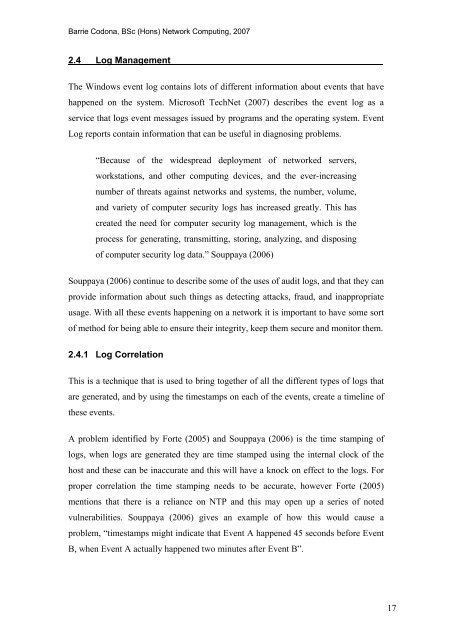Analysis and Evaluation of the Windows Event Log - Bill Buchanan
Analysis and Evaluation of the Windows Event Log - Bill Buchanan
Analysis and Evaluation of the Windows Event Log - Bill Buchanan
Create successful ePaper yourself
Turn your PDF publications into a flip-book with our unique Google optimized e-Paper software.
Barrie Codona, BSc (Hons) Network Computing, 2007<br />
2.4 <strong>Log</strong> Management<br />
The <strong>Windows</strong> event log contains lots <strong>of</strong> different information about events that have<br />
happened on <strong>the</strong> system. Micros<strong>of</strong>t TechNet (2007) describes <strong>the</strong> event log as a<br />
service that logs event messages issued by programs <strong>and</strong> <strong>the</strong> operating system. <strong>Event</strong><br />
<strong>Log</strong> reports contain information that can be useful in diagnosing problems.<br />
“Because <strong>of</strong> <strong>the</strong> widespread deployment <strong>of</strong> networked servers,<br />
workstations, <strong>and</strong> o<strong>the</strong>r computing devices, <strong>and</strong> <strong>the</strong> ever-increasing<br />
number <strong>of</strong> threats against networks <strong>and</strong> systems, <strong>the</strong> number, volume,<br />
<strong>and</strong> variety <strong>of</strong> computer security logs has increased greatly. This has<br />
created <strong>the</strong> need for computer security log management, which is <strong>the</strong><br />
process for generating, transmitting, storing, analyzing, <strong>and</strong> disposing<br />
<strong>of</strong> computer security log data.” Souppaya (2006)<br />
Souppaya (2006) continue to describe some <strong>of</strong> <strong>the</strong> uses <strong>of</strong> audit logs, <strong>and</strong> that <strong>the</strong>y can<br />
provide information about such things as detecting attacks, fraud, <strong>and</strong> inappropriate<br />
usage. With all <strong>the</strong>se events happening on a network it is important to have some sort<br />
<strong>of</strong> method for being able to ensure <strong>the</strong>ir integrity, keep <strong>the</strong>m secure <strong>and</strong> monitor <strong>the</strong>m.<br />
2.4.1 <strong>Log</strong> Correlation<br />
This is a technique that is used to bring toge<strong>the</strong>r <strong>of</strong> all <strong>the</strong> different types <strong>of</strong> logs that<br />
are generated, <strong>and</strong> by using <strong>the</strong> timestamps on each <strong>of</strong> <strong>the</strong> events, create a timeline <strong>of</strong><br />
<strong>the</strong>se events.<br />
A problem identified by Forte (2005) <strong>and</strong> Souppaya (2006) is <strong>the</strong> time stamping <strong>of</strong><br />
logs, when logs are generated <strong>the</strong>y are time stamped using <strong>the</strong> internal clock <strong>of</strong> <strong>the</strong><br />
host <strong>and</strong> <strong>the</strong>se can be inaccurate <strong>and</strong> this will have a knock on effect to <strong>the</strong> logs. For<br />
proper correlation <strong>the</strong> time stamping needs to be accurate, however Forte (2005)<br />
mentions that <strong>the</strong>re is a reliance on NTP <strong>and</strong> this may open up a series <strong>of</strong> noted<br />
vulnerabilities. Souppaya (2006) gives an example <strong>of</strong> how this would cause a<br />
problem, “timestamps might indicate that <strong>Event</strong> A happened 45 seconds before <strong>Event</strong><br />
B, when <strong>Event</strong> A actually happened two minutes after <strong>Event</strong> B”.<br />
17










![Unit 5. Switches and VLANs [PDF]](https://img.yumpu.com/34422504/1/184x260/unit-5-switches-and-vlans-pdf.jpg?quality=85)





